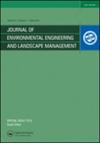THE DEVELOPMENT STAGE OF XIAMEN CITY AND RELATED ENVIRONMENT EVOLUTION
IF 1.1
4区 环境科学与生态学
Q4 ENVIRONMENTAL SCIENCES
Journal of Environmental Engineering and Landscape Management
Pub Date : 2022-09-06
DOI:10.3846/jeelm.2022.17407
引用次数: 0
Abstract
A model of environmental evolution of cities, especially in East Asia, is said to follow four stages. The pathways to the fourth stage of eco-city are not always clear, but need to be contextual. This research extended the original stage model of environmental evolution to describe urban development and its impact on the environment, especially integrated a model comprise of density, mix and accessibility (DMA) for urbanization and applied Ecological Footprint (EF) concept for pressure on eco-environment. The research analyzed the Xiamen City in China through the first three stages in order to gain insights how the city might be able to hasten its transition to the fourth stage of an eco-city. As expected, the development of Xiamen City and its environmental impacts has very obvious stage characteristic. Before 2010, Xiamen City got through a long time of Stage I (poverty stage); and in the period of 2010 to 2019, Xiamen experienced the Stage II (industrial pollution stage) and Stage III (mass consumption stage) crossly. The new built-up land in the decade of 2000–2010 is much larger than the previous 10 years from 1989 to 2000, 5 times more. Meanwhile, compared with 1980–1995, the ecological deficit also enlarged greatly in period of 1995–2010. Considering up to 2019 Xiamen still has large amount of energy consumption and high level output of industry solid waste, Xiamen should take measures of adjusting the industrial structure, promoting the green industry and planning the urban growth boundary to achieve the eco-city stage.厦门城市发展阶段及其环境演变
城市环境演变的模式,特别是在东亚,据说遵循四个阶段。通往生态城市第四阶段的路径并不总是清晰的,但需要有语境。本研究扩展了原有的环境演化阶段模型来描述城市发展及其对环境的影响,特别是整合了城市化的密度、混合和可达性(DMA)模型和应用生态足迹(EF)概念来描述生态环境压力。本研究通过前三个阶段对中国厦门市进行了分析,以了解厦门市如何加速向生态城市第四阶段的过渡。正如预期的那样,厦门市的发展及其环境影响具有非常明显的阶段性特征。2010年以前,厦门市经历了漫长的第一阶段(贫困阶段);2010 - 2019年,厦门经历了第二阶段(工业污染阶段)和第三阶段(大众消费阶段)。2000 - 2010年10年间新增建设用地比1989 - 2000年10年间增加了5倍。与1980-1995年相比,1995-2010年期间生态赤字也大幅扩大。截至2019年,厦门市仍存在能耗大、工业固体废物产出量高的问题,应采取调整产业结构、推进绿色产业、规划城市增长边界等措施,实现生态城阶段。
本文章由计算机程序翻译,如有差异,请以英文原文为准。
求助全文
约1分钟内获得全文
求助全文
来源期刊
CiteScore
1.90
自引率
7.70%
发文量
41
审稿时长
>12 weeks
期刊介绍:
The Journal of Environmental Engineering and Landscape Management publishes original research about the environment with emphasis on sustainability.

 求助内容:
求助内容: 应助结果提醒方式:
应助结果提醒方式:


